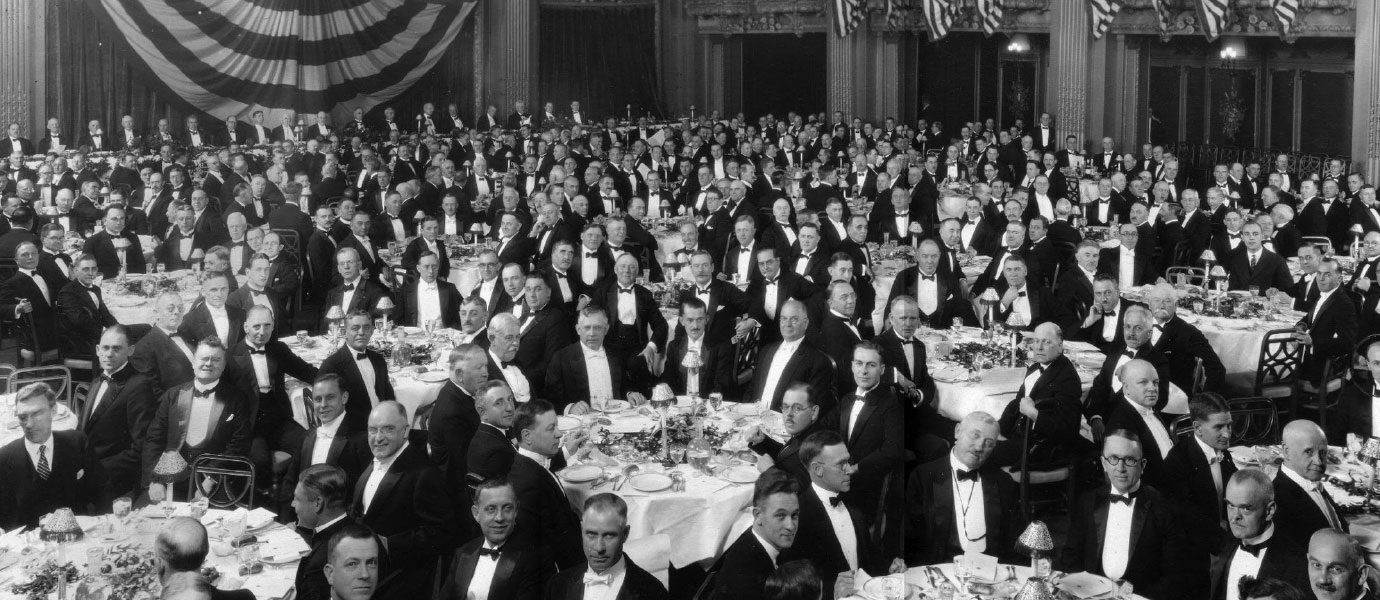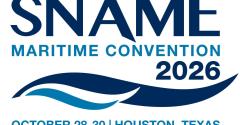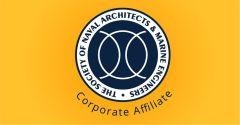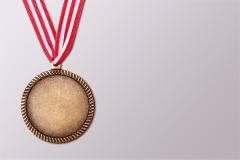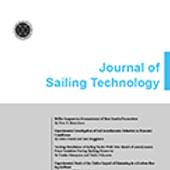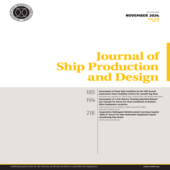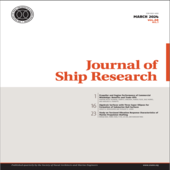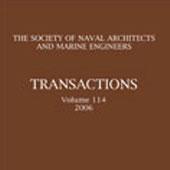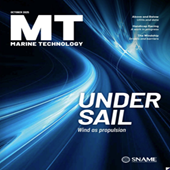Technical and research (T&R) | Bulletins and reports
The efficiency of a ship design and its structural integrity hinge upon the extent to which design loads adequately represent the corresponding true service loads expected. Historical methods employed to determine hull-girder design loads are not suitable for the design of many of the newer types of surface ships that continue to be proposed.
A new way of model testing in waves was developed that includes at the same time the measurement of ship motions, wave loads (both ordinary wave induced and hydrodynamic impact), and the ship structural response. This approach became possible partially by evolving model testing techniques over the years, but especially through newly developed testing techniques, instrumentation, and data collection systems for this type of testing. This report documents these model testing techniques and provides a reference point for future testing and innovation in the field.
This T&R Bulletin provides a unique and practical guide to materials engineering for the maritime industry. It covers aspects of materials engineering, testing and evaluation, corrosion, and failure that are of specific interest to marine designers as well as those who maintain structure and machinery in the marine environment. The guide also provides information on the non-destructive test and evaluation techniques and their use and addresses advanced materials and processes. Additional references are provided to assist those who require more detailed information on a specific process.
Part I of this Bulletin lists each research project report to The Society of Naval Architects and Marine Engineers in response to its inquiry to industry requesting information on projects concerned with the design, development, construction, and use of ships' machinery. Where the statement is made that "results are of a proprietary nature," "tests are..." "details are ... ",etc., it should not be construed that information is not available. In general, the correspondent may discuss the project with qualified inquirers on the basis of an exchange of information; or may discuss results, methods, details, etc., depending upon the nature of the inquiry and the inquirer.
Part I of this Bulletin lists research projects reported to The Society of Naval Architects and Marine Engineers in response to an inquiry to industry requesting information on projects concerned with the design, development, construction, and use of ships' machinery.
Part II of this Bulletin lists projects which are part of the research and development program of the Bureau of Ships, Department of the Navy. They have been selected as being of interest and closely related to the topics reported in Part I of this directory. Each project reported in Part II is identified by a project number. All correspondence concerning information on these projects should refer to the identifying number. Such correspondence should be addressed to the Chief, Bureau of Ships, Attention, Code 327 Department of the Navy, Washington 25, D.C.
In parts I and II where the statement is made that "results are of a proprietary nature, "tests are ... ' "details are ... ," etc., it should not be construed that information is not available. In general, the correspondent may discuss the project with qualified inquirers on the basis of an exchange of information; or may discuss results, methods, details, etc., depending upon the inquirer and the nature of the inquiry.
Part I of this Bulletin lists research projects reported to The Society of Naval Architects and Marine Engineers in response to an inquiry to industry requesting information on projects concerned with the design, development, construction, and use of ships' machinery.
Part II of this Bulletin lists projects which are part of the research and development program of the Bureau of Ships, Department of the Navy. They have been selected as being of interest and closely related to the topics reported in Part I of this directory. Each project reported in Part II is identified by a project number. All correspondence concerning information on these projects should refer to the identifying number. Such correspondence should be addressed to the Chief, Bureau of Ships, Attention, Code 362 Department of the Navy, Washington 25, D.C.
In parts I and II where the statement is made that "results are of a proprietary nature," "tests are ... ," "details are ... ," etc., it should not be construed that information is not available. In general the correspondent may discuss the project with qualified inquirers on the basis of an exchange of information; or may discuss results, methods, details, etc., depending upon the inquirer and the nature of the inquiry.
A part of the charter of Panel M-9 is to "develop a Guide to the Selection of Backing Power." An essential basis for such a guide is a method for calculating stopping ability. This Research Bulletin is an interim report on that phase of the panel's work. The report is not a final, finished product, but is presented herewith in abbreviated form with the hope of stimulating interest in applying the proposed method to the solution of practical operating or design problems, and in checking the method by comparing calculated results with available trial data. Information forwarded to the authors on the results of such calculations will be of great assistance to them in their continuing work on simplifying, extending, and improving the method. The results of this further work will be published with a complete derivation of all equations and a discussion of the basic theory, use, limitations, and accuracy of the method.
At the 1950 annual meeting of the Society of Naval Architects and Marine Engineers a paper entitled "The Backing Power of Geared Turbine Driven Vessels" was presented by E. F. Hewins, H. J. Chase, and A. L. Ruiz, based on the full scale backing tests of the S.S. ESSO SUEZ. This paper received wide attention from ship operators and designers evidencing the interest in the problems of stopping and maneuvering ships where backing power was the main factor. The conclusions derived by the authors indicated the desirability of extending their work to cover other types of ships, prime movers, and power transmissions, and the development of a method of calculation therefor. With the modern trend towards increasing speeds, the installed ahead power of new ships has increased steadily. These vessels will necessarily operate in restricted waters, where maneuvering is most important, at a fraction of ahead rated power much smaller than that of their predecessors. Because of these facts, some members of the marine industry believed that arbitrary selection of backing power expressed as a percentage of the ahead power, such as the well known "80 percent torque at 50 pet cent revolutions per minute" for steam turbines, needed further analysis with respect to the power plant and propeller influence on the stopping of ships, and that means to establish and evaluate backing power requirements on a rational basis were highly desirable.
The Atomic Energy Panel, M-13, was organized in 1955 under the sponsorship of the Ships Machinery Committee of the Society of Naval Architects and Marine Engineers to collect such information regarding nuclear power as would be of interest to the members of the Society and to consider the impact of the application of nuclear power to merchant ships. Later that year the Coast Guard, recognizing the need for a considerable study of the problems involved, and the desirability of industry participation in such a study, requested the Society to authorize its Atomic Energy Panel to act in an advisory capacity to the Coast Guard in the development of recommendations for the safe application of nuclear power to merchant ships.
The Society agreed to this request and expanded the Panel to include members who are knowledgeable in design, application, construction, and operation of nuclear reactors as well as representatives of ship designers, builders, and operators. Since that time the Panel has devoted its attention primarily to the preparation of this document. The basic difference in. the safety problem between a nuclear-powered ship and a conventionally powered one is that provision must be made to control, under all foreseeable circumstances, the radioactivity which results from the fission process. Sufficient experience is now available to show that a serious nuclear accident will not happen if the design is adequate, the equipment is sound and proper operating procedures are followed. In addition, it is only through intensive design effort that a "bomb reaction" can be obtained, thus relegating the maximum energy release to the order of that of a small chemical explosion. Significantly, for the reactor types under consideration, this energy yield and associated fissionable material can be contained by suitable closures to prevent the uncontrolled release of radioactive material. The type of fuel used, the fuel cladding, the primary coolant system, the containment system, and the ship's hull are examples of the extensive safety back-up against the loss of radioactive material. As a practical matter it has been considered that until more actual experience has been obtained, nuclear reactors will be installed in merchant ships of fairly large size only. Consideration has been given to the results of past marine casualties involving similar size ships and the recommendations have been made with the intent of preventing the dangerous uncontrolled release of fission products in the event of such casualties. In particular, the work of the Panel has consisted of consideration of only two reactor types and ten general categories, as is indicated in the title and shown in the table of contents. In these areas, the panel has attempted to consider questions such as containment, waste disposal, and ship operation on as realistic a basis as is now possible considering the present lack of actual operating experience, so that the nuclear-propelled ship will be reliable and safe, it is of particular importance to understand that these recommendations are intended to supplement, and not to replace any part of two areas of safety considerations already established, i.e. the overall question of reactor safety as considered by the United States Atomic Energy Commission through the Advisory Committee on Reactor Safeguards under the Atomic Energy Act of 1954 and the question of pennissible radiation exposure for crew and whole population as established by applicable A.E.C. licensing regulations.
In addition, it is recommended that the nuclear ship meet the highest safety standards represented by the normal requirements of the U.S. Coast Guard and the American Bureau of Shipping with regard to the non-nuclear features of the design. The work of the Panel may be summarized by the following tentative conclusions:
1. Water-cooled and water-moderated reactors can provide safe, reliable propulsive power without imposing new operational restrictions on the ship as compared to conventionally-powered ships except for the special provisions during refueling and radioactive waste disposal.
2. Rules, regulations and inspection should ultimately be established to ensure that a nuclear-powered ship meets or exceeds the minimum requirements as regards safety and equipment, in a manner similar to that imposed for certification of conventional ships.
3. The following sections are intended to provide a guide for such rules and regulations which may be used during the interim period preceding accumulation of actual operating experience of nuclear-powered ships.
The Society has initiated two research projects relating to marine propeller and propeller shaft assemblies. The first of these was Project M-8 Investigation of Tailshaft Failures, initiated in 1950. The second, an outgrowth of the first, was set up separately in 1953 as Project M-11, Investigation of Propeller Huh Sealing Arrangements. In the early phase of the work of panel M-8, the principal factors contributing to failures of tail shafts were assessed to include periodic stress reversal, stress variation, fretting corrosion, and corrosion due to ingress of seawater. Since the protection of the steel shaft within the propeller hub should be under the control of the designer and the installing agency, and since the possibility of the tail shaft "corrosion fatigue" can be minimized by attention to details, this aspect of the problem was considered to be of sufficient importance to pursue as a separate project. An interim report on this investigation was published in the SNAME Bulletin for July 1956.
The present and final report summarize the work and recommendations of the panel membership for Project M-11. This is endorsed by and offered to the industry by the Ships' Machinery Committee.
